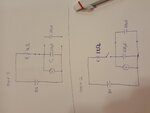Akanimo
Advanced Member level 3

 Make a setup like that shown in this diagram in the attached photograph. The voltage source does not necessarily have to be a battery. Any DC power supply is okay. You can try the scenario in the book by acquiring the components.
Make a setup like that shown in this diagram in the attached photograph. The voltage source does not necessarily have to be a battery. Any DC power supply is okay. You can try the scenario in the book by acquiring the components.After connecting step one diagram, allow some time for the capacitor to be charged to 10V. Then connect the voltmeter and measure the voltage V1 across the capacitor and calculate for W1 using W1 = 0.5*C1*V1^2 just like Klaus has stated. Then disconnect the voltmeter. Then open the switch. Then connect the 100uF-capacitor across the 220uF-capacitor (to obtain the capacitance C2 = 220uF +100uF) taking care not to short-circuit the leads of the charged capacitor and not to get zapped (remember, it's got some energy stored in it). Then connect the voltmeter across the parallel-connected capacitors and measure the voltage V2 across them. You'll notice that the voltage has dropped from 10V to 6-point-something volt.
Calculate for the new energy W2 with W2 = 0.5*C2*V2^2.
The value of W2 that you are going to calculate may be a little different from that which I calculated in post #12. This is due to the fact that the capacitance of the capacitors are not exactly 220uF and 100uF but lie somewhere within their specified tolerance.
Last edited:
